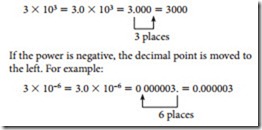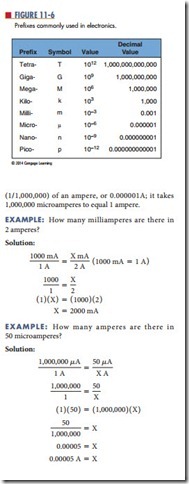scientific notation
In electronics, it is common to encounter very small and very large numbers. scientific notation is a means of using single-digit numbers plus powers of 10 to express large and small numbers. For example, 300 in scientific notation is
The exponent indicates the number of decimal places to the right or left of the decimal point in the number. If the power is positive, the decimal point is moved to the right. For example:
Figure 11-6 lists some commonly used powers of 10, both positive and negative, and the prefixes and symbols associated with them. For example, an ampere (A) is a large unit of current that is not often found in low-power electronic circuits. More frequently used units are the milliampere (ma) and the microampere (ma). A milliampere is equal to one-thousandth (1/1000) of an ampere, or 0.001 A. In other words, it takes 1000 milliamperes to equal one ampere. A microampere is equal to one-millionth

